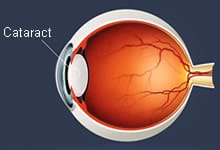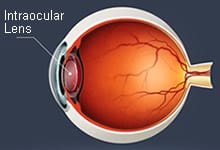A cataract is a common condition that causes a clouding of the eye’s natural lens. Cloudiness develops as a result of a buildup of protein in the lens. Cataracts affect millions of people each year, including more than half of all Americans over the age of 65.


There are a wide range of replacement lenses available to cataract patients, each offering different advantages for your post-surgery vision. The most effective lens depends on each patient’s individual preferences and goals for their vision. Before premium lenses, patients were unable to see clearly at both near and far distances without the use of eyeglasses or contact lenses.
Cataract Surgery – Frequently Asked Questions
The best time to consider cataract surgery is when you cataracts begins to affect your activities of daily life. This could include difficulty seeing while driving at night or watching television, difficulty seeing small print on your cell phone, medicine bottle, or labels, or difficulty seeing the computer screen.
Cataract Surgery has a relatively speedy recovery, but there are a few minor restrictions after cataract surgery. Patients are advised to avoid swimming for 1 week and should not put makeup around the eye for 1 week after surgery. Patients are also required to use eye drops after surgery (usually up to 1 month after surgery). You may resume all other normal daily activities as soon as the next day after surgery.
Most surgeons will have you use eye drops for 4 full weeks after surgery. After surgery, there are 3 different types of drops that you will be using (Antibiotic, Anti-inflammatory and Steroid). These drops will be used up to 4 times per day for the first week after surgery and will taper off each week until complete. Some doctors also require patients to start using eye drops in the day or two leading up to surgery.
